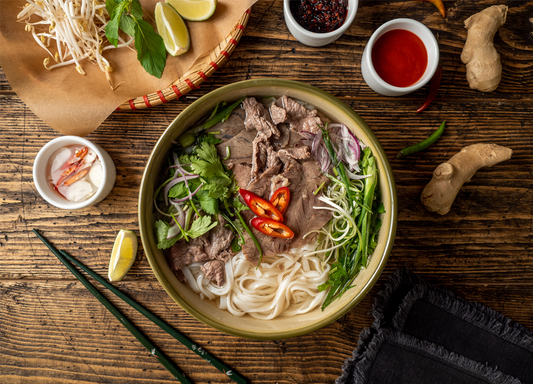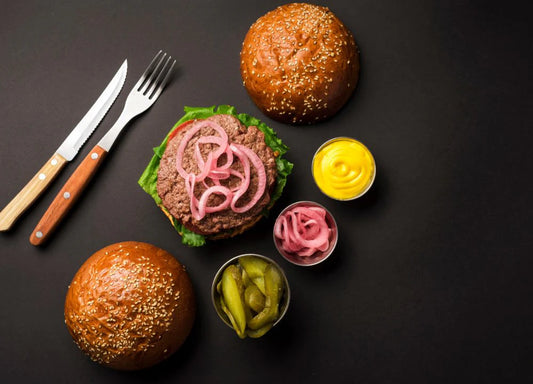Pho and Fusion Cuisine: Innovative Twists on a Classic Favorite

Introduction: The Evolution of Pho
Pho, the beloved Vietnamese noodle soup renowned for its aromatic broth, tender meat, and fresh herbs, has long been a staple of traditional Vietnamese cuisine. As global food culture becomes increasingly interconnected, chefs and restaurateurs are experimenting with fusion cuisine, blending traditional dishes with flavors and techniques from around the world. Pho, with its rich culinary heritage, has become a canvas for creative innovation. This article explores how pho is being transformed through fusion cuisine, offering innovative twists that push the boundaries of this classic favorite.
1. Fusion Flavors: Blending Culinary Traditions
1.1. Asian Fusion Pho
Pho's adaptability makes it a prime candidate for Asian fusion cuisine. Chefs are incorporating elements from other Asian culinary traditions to create unique and exciting variations.
- Japanese Pho: Combining pho with Japanese ingredients such as miso or sake, chefs create a hybrid broth that introduces umami-rich flavors. Toppings like tempura or teriyaki-glazed meat add an additional layer of complexity.
- Thai Pho: Integrating Thai flavors, such as lemongrass, kaffir lime leaves, and Thai basil, into the broth brings a new dimension to pho. The addition of Thai-style chili paste or fish sauce can further enhance the dish's flavor profile.
- Korean Pho: Korean influences, such as kimchi or gochujang (Korean chili paste), are used to add a spicy, tangy kick to pho. Korean-style beef or pork can replace traditional proteins, adding a fusion twist.
1.2. Western Fusion Pho
Western cuisine also provides inspiration for innovative pho variations, merging classic Vietnamese flavors with contemporary Western ingredients.
- French Pho: Inspired by the French colonial influence on Vietnam, this fusion combines elements such as pâté or foie gras with traditional pho. The rich, creamy texture of foie gras complements the broth's depth, while pâté can add a unique flavor twist.
- Italian Pho: Incorporating Italian ingredients, such as sun-dried tomatoes, basil, or balsamic vinegar, creates a fusion that blends the aromatic qualities of pho with Italian culinary elements. An Italian twist might include using risotto or pasta instead of rice noodles.
2. Innovative Ingredients: Redefining the Classic
2.1. Gourmet Proteins
In high-end restaurants, traditional pho proteins are being replaced or complemented with gourmet options:
- Wagyu Beef: Replacing standard beef cuts with luxurious Wagyu beef enhances the richness and tenderness of the dish. The marbled texture of Wagyu adds a decadent touch to the broth.
- Duck Confit: Duck confit offers a flavorful alternative to traditional chicken or beef. Its rich, savory taste pairs well with the aromatic pho broth, creating a unique flavor profile.
2.2. Exotic Broth Variations
Chefs are experimenting with broth recipes, introducing new and exotic ingredients:
- Bone Marrow Broth: Adding bone marrow to the broth enhances its richness and depth, creating a luxurious texture and flavor.
- Spicy Chili Broth: Incorporating various types of chili peppers and spicy seasonings results in a broth with a bold, fiery kick. This variation caters to those who enjoy a more intense flavor experience.
2.3. Creative Noodles
Noodles are being reimagined to complement modern pho creations:
- Rice Paper Noodles: Using rice paper or rice sheets instead of traditional rice noodles offers a unique texture and appearance. These noodles can be cut into strips or rolled for a different presentation.
- Shirataki Noodles: For a low-carb or gluten-free alternative, shirataki noodles made from konjac yam can be used. They provide a distinctive texture while accommodating dietary preferences.
3. Artistic Presentation: Elevating the Dining Experience
3.1. Plating Techniques
High-end pho restaurants are focusing on artistic plating to enhance the visual appeal of the dish:
- Minimalist Presentation: Using clean lines and simple designs, minimalist plating highlights the ingredients and their colors. This approach creates an elegant and refined look.
- Interactive Dining: Some restaurants incorporate interactive elements, such as allowing diners to assemble their own pho at the table, enhancing the experience and presentation.
3.2. Garnishing and Toppings
Creative garnishing and toppings add a modern twist to traditional pho:
- Edible Flowers: Garnishing pho with edible flowers adds a burst of color and visual interest. These delicate flowers complement the dish’s presentation and enhance its overall appeal.
- Microgreens and Caviar: Using microgreens and a touch of caviar as garnishes adds sophistication and a contemporary flair. Microgreens provide a fresh, vibrant touch, while caviar adds an element of luxury.
4. Fusion Pho in Popular Culture
4.1. Restaurant Trends
Fusion pho is increasingly featured in upscale restaurants and food festivals, reflecting a growing trend toward innovative and creative cuisine. Chefs are using pho as a platform to showcase their culinary artistry and experiment with new flavors and techniques.
4.2. Social Media Influence
The visual appeal of fusion pho makes it a popular subject on social media platforms. Instagram and food blogs are filled with images of creatively presented pho dishes, driving interest and influencing dining trends.
4.3. Celebrity Endorsements
Celebrity chefs and food influencers are often at the forefront of promoting fusion pho, helping to elevate its status and introduce it to new audiences. Their endorsements and creative interpretations contribute to the dish’s evolving reputation.
5. Challenges and Considerations
5.1. Maintaining Authenticity
While fusion cuisine offers exciting possibilities, it is important to balance innovation with respect for traditional flavors. Chefs must carefully consider how new ingredients and techniques impact the essence of pho and ensure that the dish remains true to its roots.
5.2. Ingredient Availability
Incorporating exotic or unconventional ingredients may pose challenges in terms of sourcing and cost. Restaurants must navigate these challenges to ensure consistency and quality in their fusion pho offerings.
5.3. Customer Expectations
Understanding customer preferences and expectations is crucial when introducing fusion variations. Restaurants must balance creativity with the preferences of their target audience to ensure that new interpretations are well-received.

Conclusion: A Culinary Adventure
Pho's journey from a traditional Vietnamese street food to a canvas for fusion cuisine illustrates the dish's versatility and enduring appeal. By incorporating global flavors, innovative ingredients, and artistic presentation, chefs are redefining pho and pushing the boundaries of culinary creativity. Fusion pho offers a unique opportunity to explore new culinary horizons while honoring the rich heritage of this classic favorite.
As pho continues to evolve and inspire, it remains a testament to the power of food to transcend cultural boundaries and bring people together. Whether enjoyed in its traditional form or through modern fusion interpretations, pho represents a delicious adventure in the world of culinary exploration.




